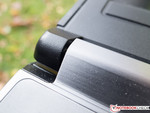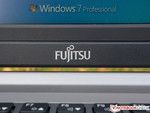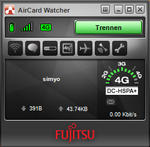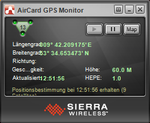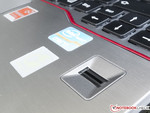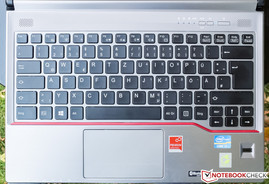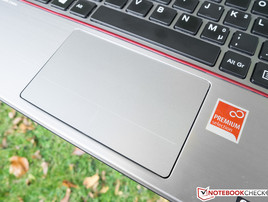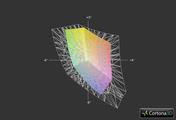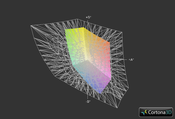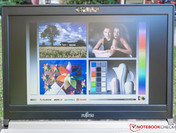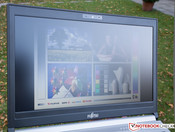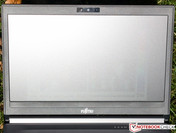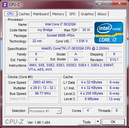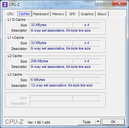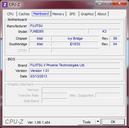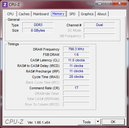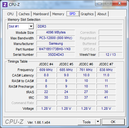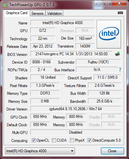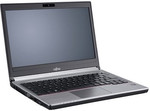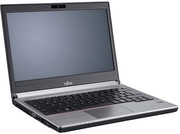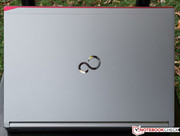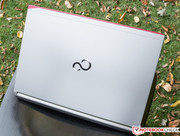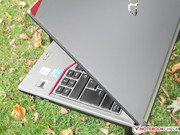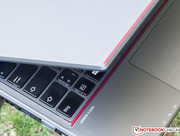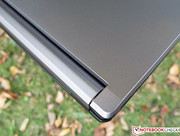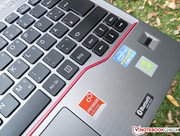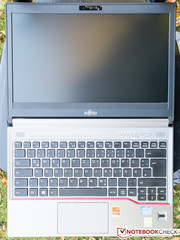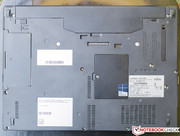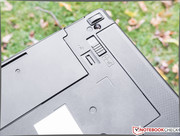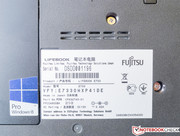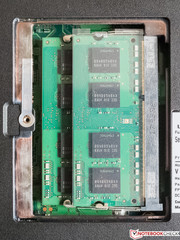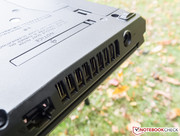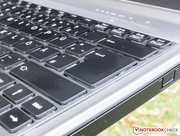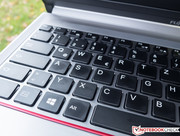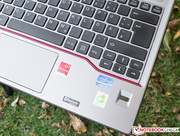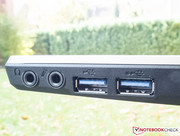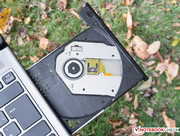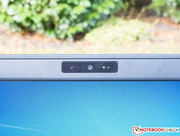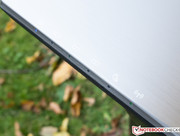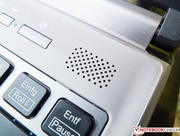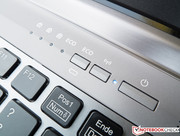Review Fujitsu LifeBook E733-0MXP41DE Premium Selection Notebook

For the original German review, see here.
The new E-series that Fujitsu introduced at the CeBit 2013 is divided in various screen sizes ranging from 13.3 (E733, 1.7 kg/~3.7 pounds) over 14 (E743, 1.9 kg/~4.2 pounds) up to 15.6 inches (E753, 2.1 kg/~4.6 pounds). According to the manufacturer, the entire line shares design, the casing's light aluminum-magnesium composition, accessories, components and software. This modular concept is to ensure more simplicity in the corporate environment and help cut administrative and management costs. For example, expenses arising from driver and BIOS updates are to be reduced by always using the same motherboard and this also facilitates company-internal support.
We will compare the review sample with two other business laptops with a slightly bigger, 14-inch size. Both sport weaker ULV dual-cores but also use SSDs and achieved a good overall rating in Notebookcheck's tests. The light, 1.8 kg (~4.0 pounds) Dell Latitude 6430u HD+ is a business ultrabook with a resolution of 1600x900 pixels and features a matte screen. The laptop has been replaced with the Latitude 7440 that we recently reviewed.
HP's EliteBook Folio 9470m ultrabook sports a matte TN screen with a resolution of only 1366x768 pixels. It just weighs 1.6 kg (~3.5 pounds) and is UMTS ready. Security features, such as Smartcard reader or TPM, are also included. It is likely that the Folio 9470m will also soon be replaced by the newly introduced EliteBook 840.
Whether the power of the quad-core, specified with a TDP of 35 Watts, installed in the review sample is really needed or whether the performance of a more runtime-friendly ULV dual-core CPU as in the comparison devices would have sufficed for the target group will be examined in our in-depth review based on many benchmarks.
Case
The base unit's underside and the display frame of Fujitsu's E733-0MXP41DE are essentially plastic. Magnesium alloys dominate the rest. The display's back and keyboard bezel is made with a velvety matte black and both the wrist rest as well as the hinge's cover feature a brushed metal look. The casing's color varies between silver and charcoal black depending on the light source. All surfaces stand out through a pleasant feel and are largely insensitive to fingerprints.
Like the other E-series laptops that we tested, the E733's build is excellent and reflects its claim and price tag appropriately. Despite its low weight, the entire construction makes an impeccable and rigid impression with a lot of attention to detail; we did not find manufacturing flaws, such as protruding edges or uneven gaps. Only the removable DVD drive has a bit of play in its compartment.
The base unit could not really be warped even with some effort. The lid's magnesium back and high-quality looking plastic frame also makes a relatively solid impression although it is only about 5 mm thin. Firm pressure applied to the back with the thumb caused isolated image distortions. The hinge that opens to approximately 190° is pulled so tight that the screen only wobbles for a moment. Both hands are needed to open the laptop.
The base unit could not really be warped even with some effort. The lid's magnesium back and high-quality looking plastic frame also makes a relatively solid impression although it is only about 5 mm (~0.2 inches) thin. Firm pressure applied to the back with the thumb caused isolated image distortions. The hinge that opens to approximately 190° is pulled so tight that the screen only wobbles for a moment. Both hands are needed to open the laptop.
Overall, it is very evident that Fujitsu's designers have put a lot of thought into the laptop and in details. The laptop makes a suitably high-quality impression. The unobtrusive, metallic-red rims elegantly set highlights that break with the usual laptop monotony. Only the height of 27 mm (~1.1 inches) is no longer quite contemporary for a 13-inch device. In return, the weight of just 1.7 kg (~3.7 pounds) is impressive in the category comparison.
Connectivity
Laptops labeled "Premium Selection", like our review sample, sport the very swift Intel Core i7-3632QM, 8 GB of RAM, a 256 GB SSD and LTE wireless data transmission. The less expensive models of the E-series are equipped with the slower Intel Core i5-3230M, 4 GB of RAM, a conventional 500 GB hard drive and UMTS instead of LTE or no mobile option at all. The docking station with a port replicator can be connected to all E-models, but it is only included in the Premium models. Although Windows 7 Professional (64-bit) is exclusively installed as the operating system, DVDs of the 32-bit version of Windows 7 Professional and Windows 8 Pro are in the box.
The array of interfaces is already great without the included port replicator. The laptop's sides sport VGA, Ethernet, 3x USB 3.0 (1 powered; can be enabled in the BIOS), DisplayPort, Kensington, power and two analog audio sockets (3.5 mm jack) as well as a slot for SD cards. As is common when ports are located on the sides, cables from external mice or peripherals such as USB sticks could interfere with the user. However, Fujitsu consistently places all ports as far toward the front as possible because of the optical drive and vent. Consequently, using a dock is recommended for stationary use.
A real highlight is the modular slot that sports the DVD burner in state of delivery. It can be replaced with a dummy to reduce the weight, a Blu-Ray drive, a laptop projector(!), or an additional battery.
The port replicator adds four more USB 3.0 ports, which reached the same speed as the ones on the laptop in the test, eSATA, 2x DisplayPort, Ethernet, DVI, VGA, Kensington, 2x audio and power. DVI and the DisplayPort cannot be used simultaneously. A second power supply for the dock is included.
The only adapter that might be required more frequently is DisplayPort-to-HDMI.
Communication
Comprehensive communication options are particularly vital for mobile business devices. The review sample does not show any shortcomings here. In addition to the inconspicuous, cabled Gigabit LAN, Wi-Fi 802.11 a/b/g/n is also available. It fortunately transmits in both the 2.4 and the still less frequently used 5 GHz band. Neither the transmission performance nor the above-average range gave reason for complaint. Intel's Centrino Advanced-N 6235 module almost consistently achieved the DSL line's limit at a distance of roughly 10 meters (~33 feet) and through two walls in the author's individual test setup.
A WWAN modem from Sierra is installed for mobile use. Its UMTS with HDSPA+ (max. 41 Mbit/s) and LTE supports the most common frequency ranges in Europe and North America. Pairing a Bluetooth headphone via the A2DP profile and playing music was no problem.
Security
Currently, more is probably not possible. A Smartcard reader and fingerprint reader enable authenticated access to the operating system. Fujitsu's laptop can be clearly identified on the Internet and in networks from everywhere in the world via the TPM module. The CPU's vPro technology facilitates remote maintenance and makes it safer. Also, the BIOS and, under Windows, the SSD or hard drives (BitLocker encryption) can be password-protected. The security bundle is rounded off by Intel's Anti-Theft technology that allows remote-locking the laptop completely in case of loss.
Accessories
We have to mention the docking station and its port replicator. Fujitsu includes a separate, additional power supply with a higher output power of 100 Watts than the other PSU with 65 Watts.
Other accessories, such as the modular battery for the drive bay, are available in Fujitsu's shop. In terms of software, the full versions of CorelDRAW and Audials One besides a few small tools for system control are installed.
Maintenance
The maintenance cover is secured by one screw and only allows accessing both occupied memory banks (DDR3, 1600 MHz, dual-channel). The SSD, fan or battery cannot be accessed.
Warranty
A 24-month bring-in warranty is included in the purchase price. Various, fee-based upgrades can be found on Fujitsu's corresponding webpage.
Input Devices
Keyboard
The chiclet-style keyboard with two brightness levels closely follows the standard layout of a conventional desktop keyboard. It also features equally sized, slightly concave keys with a light rubber coating. The drop is sufficiently long and the pressure point is easily felt. Strokes spring back smoothly and quietly. Not as nice but irrelevant for routine use: The keyboard yields marginally when the center keys are pressed with higher force. Overall, the keyboard makes a very good impression and completely fulfills the demand placed on a business laptop.
Touchpad
This verdict also applies to the Synaptic ClickPad V8.1 that exploits the available space well and only does not respond to touch at its outermost edges. Gestures using up to three fingers were always identified reliably and accurately. The driver offers detailed setting options. Both mouse buttons are only optically but not mechanically separated, and their surface detects touches. The smooth-running buttons provide a clear pressure point and a soft and quiet clicking noise provides good tactile feedback. The tester prefers lightly textured touchpad surfaces; the one in Fujitsu's E733 is completely sleek.
Display
As for the screen, Fujitsu relies on 1366x768 pixels for all small models, 1600x900 for the 14-inch devices and either 1366x768 or Full HD for the 15.6-inch laptop screens. All displays feature a matte surface.
Fujitsu uses an LED-illuminated TN screen from its own production line in our review sample. The model "FUJ5612" was installed in Fujitsu's LifeBook AH 550 that we tested in March 2010. However, unlike the review sample, it had a reflective surface. The WSXGA resolution of 1366x768 pixels is acceptable for a 13-inch laptop and results in a pixel density of 118 ppi at an aspect ratio of 16:9.
The impression is that the manufacturer fished out a display from its spare parts box when looking at the image quality. With a maximum brightness of only 202 cd/m² in the center, the poor contrast ratio of 175:1 and the extremely limited viewing angle stability both horizontally and vertically, it belongs more to a budget office laptop for 400 to 600 Euros (~$540 to 810) than a device for 1600 Euros (~$2461) that Fujitsu designed for use in professional environments. Fujitsu does not offer any alternative screens in the E-series for users who prefer 13-inch devices.
For comparison: Fujitsu's LifeBook E753 Premium Selection sister model features a 15.6 inch IPS screen with a much more stable viewing angle that has a maximum brightness of 343 cd/m² and a decent, though not outstanding contrast ratio of 730:1. Regrettably, inferior screens in laptops from this category are not an exception. HP's EliteBook Folio 9470m only achieves 217 cd/m² and 282:1, Dell's Latitude 6430u HD+ accomplishes 332 cd/m² at a contrast ratio of 329:1 and Dell's latest Latitude 7740 is just as unconvincing in terms of screen (WXGA).
The subjectively next to perfect illumination of 94% looks better. However, we cannot speak of a rich black even in "ideal" viewing angles. There was absolutely no sign of screen bleeding.
| |||||||||||||||||||||||||
Brightness Distribution: 94 %
Center on Battery: 202 cd/m²
Contrast: 176:1 (Black: 1.15 cd/m²)
ΔE ColorChecker Calman: 12.02 | ∀{0.5-29.43 Ø4.77}
ΔE Greyscale Calman: 13.4 | ∀{0.09-98 Ø5}
35.7% AdobeRGB 1998 (Argyll 1.6.3 3D)
37.75% AdobeRGB 1998 (Argyll 3D)
54.8% sRGB (Argyll 3D)
36.51% Display P3 (Argyll 3D)
Gamma: 2.35
CCT: 14841 K
While sharpness does not give reason for complaint, the low color space coverage of just 35.7% of the AdobeRGB reference color gamut backs the screen's poor rating. Normally, this aspect is only important for users who deal with (semi-) professional image editing. However, even many typical vacation photos lose a lot of their appeal due to the extremely limited color gamut and look much better on most camera displays.
Without calibration, i.e. state of delivery, the color deviations are extremely high with a DeltaE rate of 12; blue and cyan even surpass 20 (ideal: <5) and cause a strong bluish cast. An equally disastrous picture is seen in the grayscale with a rate of 13. This changes when calibrated. The shifts drop to good rates of 4 and 4; the bluish cast is eliminated (via: Xrite i1 Pro2).
It is possible to work with Fujitsu's E733 outdoors even on a sunny day owing to its matte screen. At least as long as the user sits in the shade and looks straight into the laptop. The weak brightness is noticed in direct sunlight and nothing can be recognized.
As mentioned earlier, the TN screen's poor viewing angle stability makes it difficult to find and keep a position where the deteriorating contrasts or inverted colors are not interfering. Although the tolerance is not really below average horizontally or vertically, it is unacceptable for a laptop from this price range.
Performance
Our Fujitsu LifeBook E733-0MPX41DE sports an Intel Core i7-3632QM quad-core from the Ivy Bridge generation, which is supported by 8 GB of RAM. This is true for all laptops from Fujitsu's E-series labeled "Premium Selection". The lower-priced models are powered by the slower Intel Core i5-3230M dual-core. Fujitsu relies on the Intel HD 4000 on-chip GPU that does not have a dedicated memory in all models. The premium models also feature a 256 GB SSD and conventional hard drives are installed in the others.
Processor
The Intel Core i7-3632QM has a TDP of 35 Watts and a base clock of 2.2 GHz that can be increased to 2.9 GHz via Turbo when four cores are loaded. 3.1 GHz is the limit on two cores and the maximum clock is 3.2 GHz when on only one core. Up to eight threads can be processed simultaneously via Hyperthreading.
The speed of the CPU in the review sample is as expected. The minor differences in Cinebench 11.5 multi-CPU compared with other laptops based on the same CPU are insignificant. The Turbo level of 2.9 GHz is maintained most of the time in the CPU stress test Prime95. The CPU's clock drops to the base clock of 2.2 GHz after a few seconds when the Intel HD 4000 on-chip GPU is also loaded via FurMark and sometimes falls below that marginally. The CPU's full power can be retrieved in battery mode.
The multi-CPU benchmark of Cinebench R11.5 shows that the ULV dual-cores' performance in Dell's Latitude and HP's EliteBook is a bit less than half of that from the quad-core in the review sample. Fujitsu's LifeBook E753 sister model, based on the same platform, is on a par as expected. The single-thread performance of the ULV models only lags behind marginally, which is due to the slightly lower maximum clock of 2.9 GHz on the Intel Core i5-3437U (Dell) and 2.8 GHz on the i5-3427U (HP).
The advantage of the quad-core CPU will thus only be noticed in optimized applications. The quad-core does not improve less demanding, routine office tasks.
System Performance
As we expected, the subjective performance is top-notch. Owing to the SSD, programs open swiftly and both cold starts and waking the laptop from standby are quick. Computing and memory intensive applications, such as Adobe Photoshop Lightroom 4.4, are no problem for the Fujitsu.
Since PCMark 7 did not run without errors and presented erratic scores due to outdated graphic drivers, we used PCMark Vantage and PCMark 8 Work. In particular, the latter recorded an outstanding score of 4849 points for the Fujitsu. The bulky Bullmann C-Klasse 3 SRD 14 Touch (German) rugged laptop based on the same platform + Plextor SSD only surpasses that by 5%.
PCMark Vantage's total score identifies Fujitsu's E733 as the fastest laptop with a quad-core and Intel HD 4000. Fujitsu's LifeBook E753 lags behind by 13% despite an identical CPU, GPU and SSD. HP's EliteBook Folio 9470m (Core i5-3427U) falls behind by a tolerable 23% and Dell's Latitude 6430u HD+ (3437U) by 15%. PCMark Vantage's Productivity benchmark shows a similar setback for the Dell, but HP's laptop accomplishes a marginal plus of 3%, which we cannot explain.
Dell's latest Latitude E7440 (i5-4200U/HD 4400/HDD) only manages 41% of the LifeBook's score with 6449 points. This is likely primarily due to the installed HDD.
| PCMark 8 - Work Score Accelerated (sort by value) | |
| Fujitsu Lifebook E733-0MXP41DE | |
| Fujitsu Lifebook E753 Premium Selection | |
» No benchmarks for this notebook found!
| PCMark Vantage Result | 15848 points | |
| PCMark 7 Score | 763 points | |
| PCMark 8 Home Score Accelerated | 3585 points | |
| PCMark 8 Creative Score Accelerated | 3166 points | |
| PCMark 8 Work Score Accelerated | 4849 points | |
Help | ||
Storage Devices
The relevant benchmarks confirm that Fujitsu did not install the fastest available SSD in the LifeBook E733. Compared with the Micron RealSSD C400 MTFDDAK256MAM-1K12 in the review sample, particularly the Lite-On LMT-128M3M in Dell's 6440u achieved a 12% higher performance in sequential read and 72% in the 4K-64-Thrd test, which simulates a typical program start. In return, the Intel SSD 520 Series SSDSC2W180A3L in HP's laptop is on a par with the review sample. All SSDs achieve the usual speed of around 20 MB/s in 4K read in comparison. However, the main thing for real-life use is that an SSD is installed; most users will not notice the mentioned differences.
An overview of benchmark scores for many hard drives and SSDs can be found in our FAQ section.
Graphics Card
The strength of the DirectX 11 capable, on-chip Intel HD 4000 GPU that shares the dual-channel memory with the CPU and clocks with 350-1150 MHz even in battery mode is not found in performance but in energy efficiency. It is primarily installed in portable laptops with a focus on decent battery runtimes and/or the gaming performance is unimportant, like in our LifeBook.
Dell also uses the HD 4000 in its Latitude 6430u and is consequently roughly on a par with the Fujitsu in 3DMark (2013) Cloud Gate Graphics and 3DMark 11 (GPU performance). The results also apply to HP's EliteBook 9470m. Dell's E7440 (HD 4400) clearly lags behind with 3832 points.
More details can be found in the chart below and in our benchmark list for many mobile graphics cards and details about the games we use.
| 3DMark 06 Standard Score | 7003 points | |
| 3DMark 11 Performance | 727 points | |
| 3DMark Ice Storm Standard Score | 33724 points | |
| 3DMark Cloud Gate Standard Score | 5235 points | |
Help | ||
Gaming Performance
The Intel HD 4000 does not make the Fujitsu into a gaming laptop; quite the opposite is true. Current, graphically sophisticated games can usually only just be played smoothly in minimum settings. Casual gamers will have to be satisfied with older or less demanding games, such as Diablo III or FIFA 14 that are fun to play in medium and sometimes even high settings.
| low | med. | high | ultra | |
|---|---|---|---|---|
| Anno 2070 (2011) | 50.2 | 24.4 | 15.5 | |
| Tomb Raider (2013) | 35.8 | 18.3 | 11.3 | |
| BioShock Infinite (2013) | 32.6 | 18.9 | 14.4 |
Emissions
System Noise
In terms of noise, the LifeBook E733 is pleasantly restrained. When the fan runs in idle mode, it is so quiet that it does not stand out from the noises in hushed surroundings. The noise is very audible in medium loads. The laptop can be called loud during full load (Prime95 + FurMark) that only last for fractions of a second in practical use. However, it is not distracting because there are no background noises, such as high-pitched buzzing. The fan management does not cause unnecessary speed fluctuations, but rather regulates it quite subtly and, subjectively, smoothly.
Noise level
| Idle |
| 29.6 / 29.6 / 33.6 dB(A) |
| DVD |
| 38.1 / dB(A) |
| Load |
| 40 / 49.3 dB(A) |
 | ||
30 dB silent 40 dB(A) audible 50 dB(A) loud |
||
min: | ||
Temperature
Fujitsu's compact laptop already gets quite warm when idling. However, that is only on the underside where we measured up to 47 °C (116.6 °F) in some areas. We also noticed while typing that the wrist rest's left is always warmer than on the right. That was a bit irritating at first, but not unpleasant.
This is different during full load. The review sample exceeded 50 °C (122 °F) on its underside and we recorded temperatures around 40 °C (104 °F) at the right front, which might be a bit too much for sensitive users.
The core temperatures never surpassed 93 °C (199.4 °F) in the stress test. Although that is high, it is still within the tolerance range. As described in "Processor", thermal throttling does not occur when only the CPU is loaded; this is only the case when the graphics unit is also stressed.
(±) The maximum temperature on the upper side is 41.2 °C / 106 F, compared to the average of 35.9 °C / 97 F, ranging from 21.4 to 59 °C for the class Subnotebook.
(-) The bottom heats up to a maximum of 50.6 °C / 123 F, compared to the average of 39.3 °C / 103 F
(±) In idle usage, the average temperature for the upper side is 34.1 °C / 93 F, compared to the device average of 30.8 °C / 87 F.
(±) The palmrests and touchpad can get very hot to the touch with a maximum of 39.1 °C / 102.4 F.
(-) The average temperature of the palmrest area of similar devices was 28.2 °C / 82.8 F (-10.9 °C / -19.6 F).
Speakers
The speakers' produce the typical tinny sound, caused by a too low a volume, laptops are known for. Considering the low capacities of both speakers, the balance is quite decent. Although we cannot speak of real bass, the instruments can be identified and there is even a bit of perceptible surround sometimes. Unfortunately, the speakers are too quiet to completely fill a 30 m² (~323 sq ft) room with sound but they do not distort in maximum volume. The Realtek ALC269 does a good job when connected to the stereo system at home. Nevertheless, they do not quite reach the dynamics or clarity of, for example, a Creative X-Fi sound card (PC).
Energy Management
Power Consumption
Looking at the idle power consumption, the review sample is located in the upper third among 1-inch laptops. The average rates are in the lower midfield during load. The quad-core CPU takes its toll here. Fujitsu's laptop still consumes 0.2 Watts from the outlet when turned off, which is unnecessary nowadays. The majority of contenders are also more restrained in standby (0.4 Watts).
The higher the load the higher the review sample's consumption compared with the test laptops based on ULV processors. The power consumption is on the same level during low load, but the review sample requires approximately 50% more energy in full load. The laptop's power supply has an output power of 65 Watts; the maximum power consumption of 62 Watts is just below that.
| Off / Standby | |
| Idle | |
| Load |
|
Key:
min: | |
Battery Runtime
The battery runtime is determined by the laptop's power consumption and the battery's capacity, which is quite lush with 69 Wh. Dell's laptop uses a 60 Wh battery and HP's device sports a 52 Wh model. Nevertheless, the ULV-based comparison laptops surpass the Fujitsu in battery runtime. The review sample lasted 324 minutes (approx. five and a half hours) in the practice-oriented Wi-Fi test, which is a good rate for the hardware platform. Dell opposes this with 449 minutes and HP reaches 459 minutes. The ULV-advantage even increases to 42% (Dell) and 91% (HP) during load.
However, we should keep in mind that the battery life of Fujitsu's laptop can be increased significantly via the modular battery available for the drive bay, when required.
Verdict
The casing of Fujitsu's LifeBook E733-0MXP41DE looks stylish and makes a high-quality and rigid impression. The low weight, decent battery runtimes and abundant security features ensure reliable and long-lasting mobile use. The input devices meet professional demands, the diversity of interfaces and included docking station point to the target group of business users. Company administrators will be pleased about Windows 7 Pro as well as the, as far as possible, uniformly structured platforms of the entire E-series, which could help reduce administrative and support expenses.
So far, so good. The potential buyer will see the steep price of approximately 1600 Euros (~$2461) acceptable up to here. However, the poor image quality of Fujitsu's own screen is not appropriate. Unfortunately, the best thing about the screen is in fact its matte surface. Fujitsu made cutbacks in the wrong places here and ruins the very good overall impression that the review sample might have made.
Savings could have been made in, for example, the CPU. A bit less would have been enough in this case, particularly since using a CPU with a lower TDP would have improved the good battery runtime even more. Then again, the performance - except in games - is beyond any doubt.


